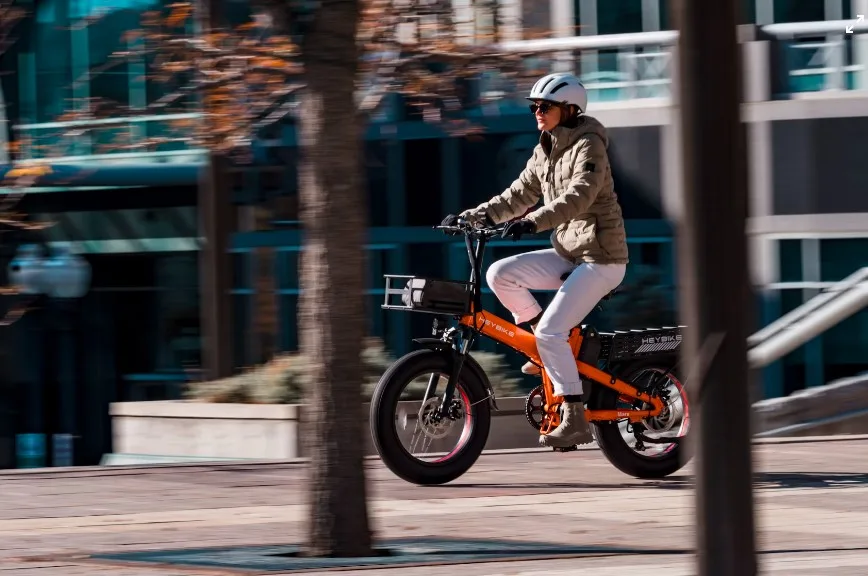Electric bikes, commonly known as e-bikes, have surged in popularity in recent years, transforming the way people commute, explore, and enjoy outdoor adventures. With increasing environmental consciousness, more individuals are turning to e-bikes as a sustainable and efficient mode of transportation.
However, before you head to your nearest store to buy your new ride, consider whether it’s hardtail or full suspension. Understanding the differences between these two types of e-bikes is crucial for prospective buyers seeking the perfect ride for their needs. Let’s explore both options in detail.
Full Suspension E-bikes
Full suspension e-bikes boast both front and rear suspension systems. This dual-suspension setup provides riders with enhanced comfort, control, and traction, particularly on rough and technical terrain. Full suspension e-bikes are favored by avid mountain bikers and off-road enthusiasts who demand peak performance and versatility from their rides.
While these e-bikes offer undeniable benefits in terms of ride quality and capability, they come at a premium price. The added complexity of rear suspension components contributes to higher manufacturing costs, resulting in a higher price tag compared to hardtail models. Despite the upfront investment, many riders find the superior comfort and confidence provided by a full suspension ebike well worth the price.
Benefits of Full Suspension E-bikes
Full suspension ebikes elevate the riding experience to new heights, offering unparalleled comfort, control, and confidence on challenging terrain. The rear suspension absorbs bumps, roots, and rocks with ease, smoothing out rough trails and reducing rider fatigue. This enhanced comfort allows riders to tackle longer rides and more technical terrain with greater ease, opening up new possibilities for exploration and adventure.
Moreover, full suspension e-bikes excel in providing traction and stability, particularly in variable trail conditions. The rear suspension maintains tire contact with the ground, maximizing grip and minimizing wheel slip, even on loose or slippery surfaces. This increased traction instills confidence in riders, allowing them to push their limits and conquer obstacles that would be daunting on a hardtail bike.
Hardtail E-bikes
Hardtail e-bikes feature suspension only on the front fork, while the rear remains rigid. This design distinguishes them from their full suspension counterparts, offering a simpler and more straightforward ride. One of the primary advantages of hardtail e-bikes is their affordability. With fewer components and less complexity, hardtails are often priced more competitively, making them an attractive option for budget-conscious riders.
In addition to their lower cost, hardtail e-bikes are prized for their lightweight nature. Without the added weight of a rear suspension system, hardtails excel in efficiency, especially on smoother terrains such as paved roads and well-maintained trails. Commuters, casual riders, and those seeking a reliable mode of transportation often gravitate towards hardtail e-bikes due to their nimble handling and ease of maintenance.
Benefits of Hardtail E-bikes
Hardtail e-bikes cater to a diverse range of riders, from commuters navigating city streets to weekend adventurers exploring gravel paths and light trails. Their simplicity and lower maintenance requirements make them an attractive option for beginners and seasoned cyclists alike. With fewer moving parts and less susceptibility to wear and tear, hardtail e-bikes offer a hassle-free riding experience that allows riders to focus on enjoying the journey.
How Do They Differ
The differences between hardtail and full suspension e-bikes extend beyond their suspension setups. Hardtail e-bikes, with their rigid rear frames, tend to be more efficient in transferring pedal power to the ground, making them ideal for riders who prioritize speed and responsiveness. In contrast, full suspension e-bikes sacrifice some pedaling efficiency in favor of improved traction and control over rough terrain.
Additionally, weight plays a significant role in distinguishing between the two types of e-bikes. Hardtail models, lacking the extra bulk of rear suspension components, are generally lighter and more agile, making them suitable for riders who value maneuverability and ease of handling. Full suspension e-bikes, while heavier due to their additional suspension hardware, offer superior stability and comfort, particularly on descents and technical trails.
Factors to Consider When Choosing
When choosing between hardtail and full suspension e-bikes, riders should consider several key factors to ensure they make an informed decision. First, riders should assess their riding style and preferences. Are they primarily commuting on smooth pavement, or do they aspire to tackle rugged mountain trails? Understanding how and where they intend to ride will help riders determine which type of e-bike best suits their needs.
Terrain also plays a crucial role in the decision-making process. Riders who frequent technical trails with roots, rocks, and steep descents will likely benefit from the enhanced comfort and control offered by a full suspension e-bike. Conversely, riders who stick to flat or moderately rough terrain may find that a hardtail e-bike meets their needs while offering greater efficiency and simplicity.
Budget is another significant consideration when choosing between hardtail and full suspension e-bikes. While hardtail models typically come with a lower price tag, full suspension e-bikes require a larger investment due to their advanced suspension technology. Riders should evaluate their budget constraints and weigh the long-term value and benefits of each option before making a purchase.
Additionally, riders should take the time to test ride both types of e-bikes to experience firsthand how they handle different terrain and conditions. A test ride provides invaluable insight into the feel, fit, and performance of each bike, helping riders make a more informed decision. Furthermore, seeking advice from knowledgeable bike shop staff or experienced riders can offer valuable perspectives and recommendations based on individual preferences and needs.
Addressing Common Misconceptions
Despite the growing popularity of e-bikes, there are still common misconceptions surrounding hardtail and full suspension models. One prevailing misconception is that full suspension e-bikes are always superior to hardtails. While full suspension e-bikes offer undeniable benefits in terms of comfort and control, hardtail e-bikes have their own advantages, such as lower cost, simplicity, and efficiency on smooth terrain.
Another misconception is that hardtail e-bikes are only suitable for beginners or casual riders. In reality, hardtail e-bikes appeal to a wide range of riders, from commuters and recreational cyclists to experienced mountain bikers seeking a lightweight and agile ride. Hardtail e-bikes excel in certain situations and terrain types, making them a viable option for riders of all skill levels and disciplines.
Conclusion
In conclusion, the choice between hardtail and full suspension e-bikes ultimately comes down to personal preference, riding style, and intended use. Both types of e-bikes offer unique benefits and advantages, catering to a diverse range of riders and terrain types. By understanding the differences and considering key factors such as riding style, terrain, budget, and expert recommendations, riders can make an informed decision and find the perfect e-bike to suit their needs and preferences. Whether opting for the simplicity and efficiency of a hardtail e-bike or the comfort and control of a full suspension model, one thing is certain: the joy of riding an e-bike knows no bounds.




